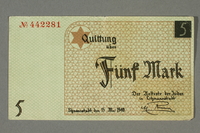Overview
- Description
- Collection of photos, copy prints, ID cards, a speech and documents relating to the experiences of Holocaust survivors Paula and Sol Dash (donor's grandparents) and their daughter Lilly (donor's mother).
- Credit Line
- United States Holocaust Memorial Museum Collection, Gift of Allison Nazarian
Physical Details
- Genre/Form
- Identification cards. Photographs. Speeches.
- Extent
-
1 folder
Rights & Restrictions
- Conditions on Access
- There are no known restrictions on access to this material.
- Conditions on Use
- Material(s) in this collection may be protected by copyright and/or related rights. You do not require further permission from the Museum to use this material. The user is solely responsible for making a determination as to if and how the material may be used.
Administrative Notes
- Holder of Originals
-
United States Holocaust Memorial Museum
- Legal Status
- Permanent Collection
- Provenance
- Donated to the United States Holocaust Memorial Museum in 2018 by Allison Nazarian, granddaughter of Paula and Sol Dash, and daughter of Lilly Dash Blankenstein.
- Record last modified:
- 2024-03-08 07:30:26
- This page:
- https://collections.ushmm.org/search/catalog/irn595263
Download & Licensing
- In Copyright - Use Permitted
- Terms of Use
- This record is not digitized and cannot be downloaded online.
In-Person Research
- Request 7 Days in Advance of Visit
- Plan a Research Visit
-
Request in Shapell Center Reading Room
Bowie, MD
Contact Us
Also in Dash family collection
The collection consists of scrip, copy prints, documents, ID cards, and photographs relating to the experiences of Paula and Sol Dash and their daughter Lilly in Poland and Germany, during and after the Holocaust.
Date: 1939-1991

Łódź (Litzmannstadt) ghetto scrip, 5 mark note issued to a Polish Jewish woman
Object
Łódź 5 mark ghetto scrip note acquired by Paula Dash, while she was forced to live in the Łódź ghetto from 1940-1944. The scrip was issued in the German-controlled ghetto from July of 1940 to its liquidation in the fall of 1944. Valuables and currency were forcibly exchanged for the scrip and it was used as modest payment for forced laborers, though it was valueless outside the ghetto. Paula was living in Łódź, Poland, with her family when Germany invaded on September 1, 1939. A week later, German forces occupied the city and quickly established an enclosed Jewish ghetto where Paula, her parents, and three siblings all lived in one small room. Her younger brother Henry, became very sick, and in 1942, her father, Aron, died from starvation. Paula was a forced laborer in a sewing factory, working ten to fourteen hour days. In August 1944, Paula, her mother, and two brothers were forced into cattle cars and transported to Auschwitz-Birkenau killing center. Upon arrival they were examined and separated. While waiting to enter the gas chamber, Paula was selected for a forced labor detail in Bremen, Germany. She spent nine months clearing rubble from Allied bombing. In the spring of 1945, Paula was sent on a death march to Bergen-Belsen concentration camp. She was liberated there on April 15, 1945, by British forces. While in the camp she contracted typhus, but recovered in a British hospital. She later married another survivor and immigrated to the United States.



